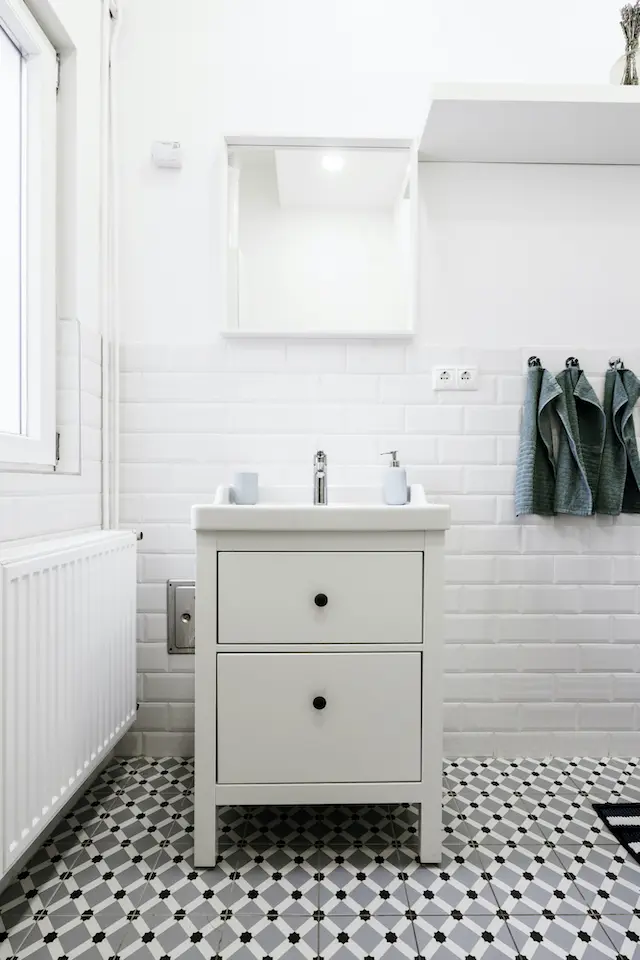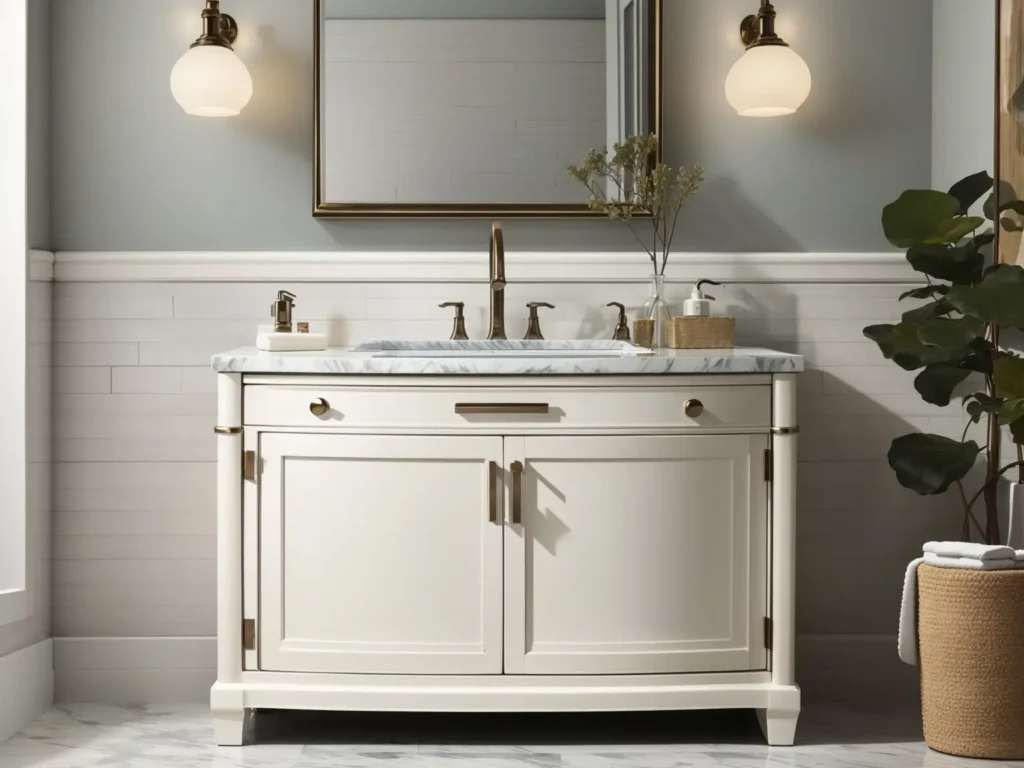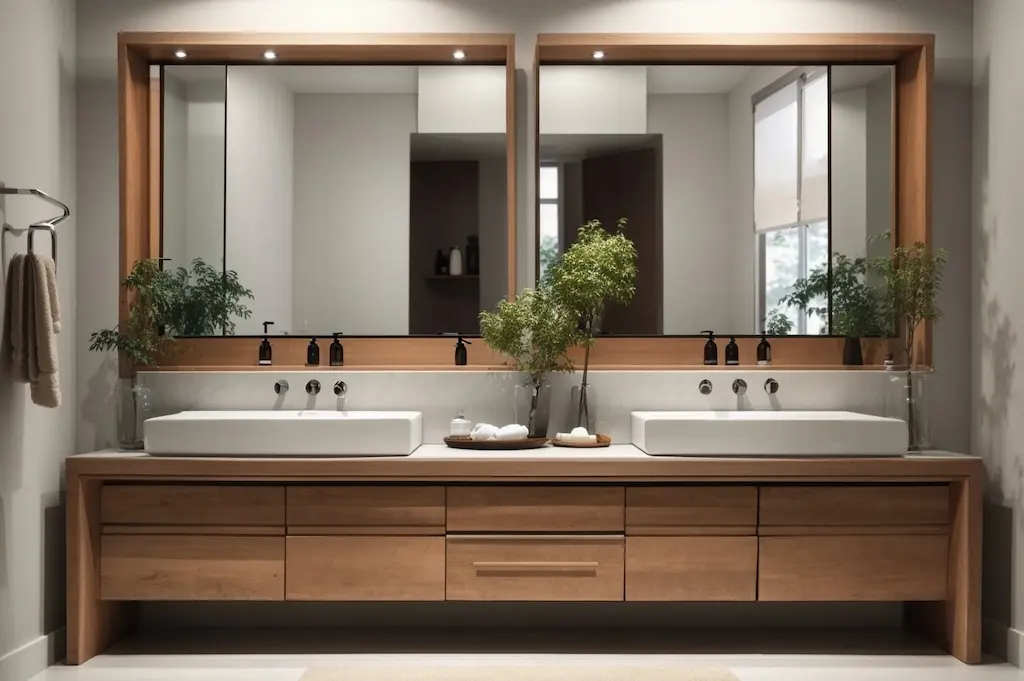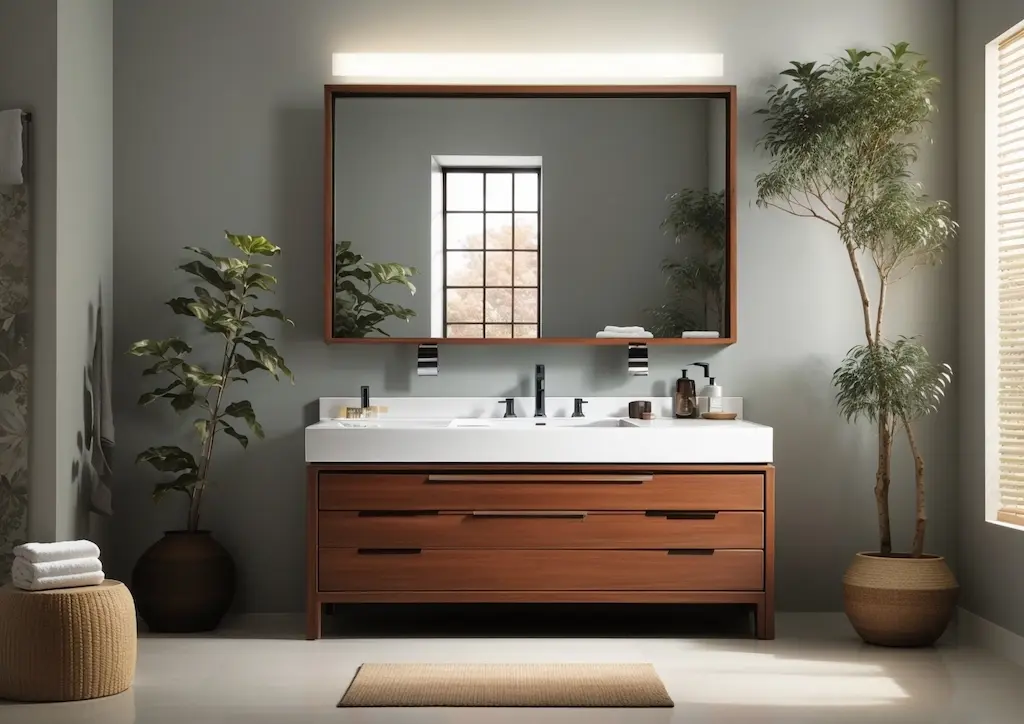My bathroom vanity was getting too old and I thought of replacing it. As I was shopping around, I realized there are some things I needed to know beforehand. So, I decided to compile my findings into this blog post hoping it would be useful to you.
What are the standard bathroom vanity sizes? For single-sink vanities, you have 24, 30, and 36 inches. And for double-sink vanities, you have 48, 60, and 72 inches.
When it comes to choosing the right bathroom vanity size, there are a few key things to consider. Starting from the dimensions and layout to storage requirements. Let’s explore everything in-depth. So read on!
Common Standard Bathroom Vanity Sizes
When choosing the perfect bathroom vanity, it helps to know the standard sizes. We’ll look at the standard sizes for single-sink vanities and double-sink vanities. So you can make an informed decision for your bathroom space.
Single-Sink Vanities
- 24 inches: Ideal for compact bathrooms or powder rooms. The 24-inch single-sink vanity offers a space-saving solution without compromising on functionality. It provides enough countertop space for essential items. It usually includes a small cabinet or drawers for storage too.
- 30 inches: A versatile option that fits well in small to medium-sized bathrooms. The 30-inch single-sink vanity offers more countertop space and storage capacity. This size strikes a balance between space-saving and usability.
- 36 inches: Perfect for medium to larger bathrooms. The 36-inch single-sink vanity provides ample countertop space and storage. It is an excellent choice for those who need more room to organize their bathroom essentials.

Double-Sink Vanities
- 48 inches: The 48-inch double-sink vanity is a popular choice for medium-sized bathrooms. It provides two sinks, making it ideal for couples or families. And it offers a generous amount of countertop space and storage.
- 60 inches: A spacious option for master bathrooms or larger shared bathrooms. The 60-inch double-sink vanity offers plenty of room for two people to use at the same time. It usually includes many drawers and cabinets, providing ample storage space.
- 72 inches: Looking for luxury and functionality? The 72-inch double-sink vanity is a great choice. It’s ideal for large master bathrooms. Additionally, it offers plenty of countertop space and storage. This makes it perfect for busy households.
These standard sizes serve as starting points to help you visualize what might work best for you. Consider the available space, your specific needs, and other customizations before choosing one. The right vanity size not only adds practicality but also elevates your bathroom.
Factors Influencing Vanity Size Selection
When looking for the perfect vanity size, your unique needs, space, and storage matter. In fact, these considerations can be crucial when evaluating options. Here are the key factors that play a significant role when choosing your ideal vanity size.
Bathroom Dimensions and Layout
Understanding the dimensions and layout of your bathroom is a good starting point. Measure the available wall space where the vanity will need to go. Account for any obstructions such as doors, windows, or fixtures. Next, consider the distance between the vanity and other bathroom elements. This is to ensure proper clearance for comfortable use. Opt for a single-sink vanity if your bathroom is small. But if your bathroom space is large, going for a double-sink option would be the way to go.
Family Needs and Lifestyle
Your family’s needs and lifestyle play an important role in choosing the right vanity size. Think about how many people will be using the bathroom. For a shared bathroom, a double-sink vanity can streamline morning routines and reduce waiting times. But, if the bathroom serves as a guest powder room, a single-sink vanity might be enough. Moreover, consider the frequency of use when making your decision.
Storage Requirements
Assessing your storage needs is essential to determine the appropriate vanity size. Take into account the items you use in the bathroom, such as towels, toiletries, and so on. Choose a vanity with enough cabinet space, drawers, or shelves to keep these items. organized and accessible. Larger vanities with ample storage are more suitable if you have many items to store. But, if you have fewer storage needs, a smaller vanity can still be functional while saving space.
By evaluating these factors you can narrow down your options. This will help you find the perfect vanity size. A size that not only fits but also enhances its functionality and aesthetics. Remember, a well-considered choice can turn your bathroom into a personalized haven. One that’s tuned to your lifestyle.
Pros and Cons of Different Sizes
Let’s take a look at the different bathroom vanity sizes and the pros and cons of each one.
Small Vanities

The highlighted feature of small vanities is space-saving advantages. They are perfect for small bathrooms, powder rooms, or cozy apartments. Also, they help maximize floor space creating an illusion of a more open and airy bathroom. Another important aspect is they work well in tight corners and alcoves. This makes them versatile options for unconventional layouts.
Small vanities have limited storage space compared to larger ones. This can be an issue if you have a lot of bathroom essentials to store. But, that can be overcome by installing wall-mounted shelves or clever organizers.
The highlighted feature of small vanities is space-saving advantages. They are perfect for small bathrooms, powder rooms, or cozy apartments. Also, they help maximize floor space creating an illusion of a more open and airy bathroom. Another important aspect is they work well in tight corners and alcoves. This makes them versatile options for unconventional layouts.
Small vanities have limited storage space compared to larger ones. This can be an issue if you have a lot of bathroom essentials to store. But, that can be overcome by installing wall-mounted shelves or clever organizers.
Medium-Sized Vanities
Medium-sized vanities strike a balance between space-saving and ample storage. They provide enough space on the countertop for everyday essentials. Besides, they may include extra drawers and cabinets to help keep your bathroom tidy.
These bathroom vanities are suitable for most bathrooms. Hence, it is the most common size you’ll find. Whether it’s a shared family bathroom or a master suite, this size works well in all situations. They also offer a practical solution that accommodates the needs of different users.

Large Vanities
The most significant advantage of large vanities is their generous countertop space. The other prominent feature is the extensive storage capacity they come with. You can easily store away all the users’ bathroom essentials in a large household. Often, large vanities feature double sinks. Thus, making them ideal for large bathrooms with many users.
Large vanities need a large bathroom. Trying to fit a large vanity inside a small bathroom is not a good idea. Not only would it make the space feel cramped but would also upset the layout. When choosing a large vanity, it’s important to make sure there is enough space around it for movement.
When choosing your bathroom vanity size, consider your needs and space availability. Small vanities are excellent space savers. Medium-sized ones offer a balance of space and storage. And, large vanities provide abundant storage but need much more bathroom space. Weighing the pros and cons will help you choose the perfect vanity size. One that harmonizes both style and practicality in your bathroom oasis.

Measuring and Planning
Accurate measurements and thoughtful planning are essential when choosing the perfect bathroom vanity. to ensure a seamless and successful installation. Let’s dive into the steps for measuring and planning. We will also explore some handy tips to optimize vanity placement in your bathroom.
Steps for Accurate Measurement
- Measure the Wall Space: Use a tape measure to record the width and height of the wall space where the vanity needs to go. Pay attention to any obstructions such as outlets, switches, or plumbing pipes. These things affect the vanity’s position.
- Account for Clearances: Allow enough clearance space around the vanity to ensure. This is to ensure comfortable usage and easy access to other bathroom fixtures. Keep at least 4 inches of space on each side of the vanity and between the vanity and the toilet or bathtub.
- Check Existing Plumbing: If you’re replacing an old vanity, measure the location of the existing plumbing. This is so the new vanity aligns with the water supply and drainage pipes. This helps prevent any surprises during installation.
- Consider Door Swing: If the vanity is close to a bathroom door, consider the direction of the door swing. This helps avoid potential obstructions when opening and closing the door.
Check this article by Home Depot for a detailed explanation on how to measure for your bathroom vanity.
Utilizing Online Tools and Software
- Virtual Room Planners: Take advantage of virtual room planning tools available online. These tools allow you to input your bathroom’s dimensions and experiment. You can virtually try out different vanity sizes and placements. With a clear visual representation, you can confidently decide on the best option.
- 3D Design Software: Explore 3D design software specialized for bathroom planning. These software applications help you create detailed layouts. Then, you can introduce various vanity styles into your layouts and see what works best. Additionally, you can even try out different finishes and accessories too.
Tips for Optimizing Vanity Placement
- Centering the Vanity: For a single-sink bathroom, consider centering the vanity on the wall. This will help achieve a symmetrical and balanced look. In double-sink vanities, place the unit closer to one side of the wall. This will give you space for a linen cabinet or extra storage.
- Floating Vanities: In smaller bathrooms, floating vanities are a clever choice. These wall-mounted vanities create the illusion of more floor space. It would give a modern and airy feel to the room.
- Lighting and Ventilation: Ensure the vanity area is well-lit and ventilated. Avoid placing the vanity directly under a light fixture or obstructing ventilation sources. This would help to maintain a comfortable and well-lit bathroom environment.
Follow these steps for accurate measurements. Use online planning tools to help you visualize where to place the vanity. This will help you choose and install the perfect bathroom vanity. Good planning is essential when making your bathroom functional and beautiful. So, take your time, measure and carefully consider your needs and style. With proper planning, your bathroom will turn into a comfortable space you’ll love.
Custom vs. Standard Sizes
Custom vanities offer special advantages because they are made just for you. You get to choose the exact size, style, and features you want. This means the vanity will fit perfectly in your bathroom, even if it’s an unusual shape or size. Plus, you can pick materials and finishes that match your taste and decor.
Also, custom vanities can be more expensive than standard ones. Since they are specially made, they need more time and effort, which can raise the cost. Yet, the extra expense may be worth it if you have unique needs or want something truly one-of-a-kind.
Standard vanities are readily available in stores, so you can take them home right away. On the other hand, custom vanities need to be made, and this takes time. You might have to wait several weeks for your custom vanity to be ready. If you have a tight timeline, this is something to keep in mind.
Choosing between custom and standard vanities is not hard. Make sure you have an idea of your budget, timeline, and personal preferences. Both options have their pros and cons, so take your time to decide when choosing your bathroom vanity.
Conclusion
Choosing the right bathroom vanity size is an important consideration. One that is essential when creating your bathroom space. By understanding the various standard sizes available, you can make an informed decision. A decision that best fits your unique needs and bathroom layout.
Small vanities offer space-saving advantages. While medium-sized ones strike a balance between space and storage. On the other hand, large vanities provide ample storage. But they need more significant bathroom space. Weighing the pros and cons of each size will lead you to the ideal choice.
Accurate measurements and proper planning are essential for a seamless installation. Using online planning tools to optimize placing your vanity for a perfect fit is a great idea. Moreover, these steps will help you create a harmonious and well-organized bathroom.
You may also consider custom vanities for a personalized touch. But keep in mind the cost and lead times involved. Standard vanities are readily available and are a cost-effective option.
In conclusion, a well-chosen bathroom vanity will enhance both functionality and aesthetics. After all, transforming your bathroom into a delightful sanctuary is the goal here. Embrace your unique style and consider your family’s needs. Let your creativity shine as you design your bathroom. With the perfect-sized vanity, your bathroom will become a space you love. So, take your time and enjoy the journey to creating your dream bathroom.
Related Questions
A standard vanity depth is around 20 to 21 inches. This depth provides enough space for the sink and countertop. Also, it leaves room for comfortable usage.
Common double bathroom vanity sizes are usually 60 inches and 72 inches. These sizes offer ample countertop space and storage. This makes them ideal for larger bathrooms or shared spaces.
Vanity units come in a range of sizes. They accommodate various bathroom dimensions and user preferences. Common single-sink vanity sizes include 24 inches, 30 inches, and 36 inches. Double-sink vanity sizes range from 48 inches to 72 inches. Additionally, a bathroom with a unique space and layout may call for a custom vanity unit.

Leave a Reply